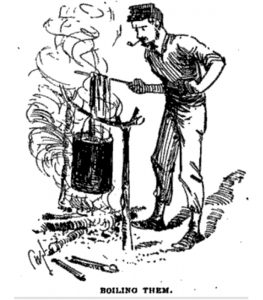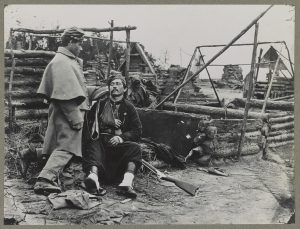Table of Contents
Disease was a large part of a soldier’s life (and death) during the Civil War. Parasites were common menaces and more than just mere annoyances. Upon taking a closer look, one can see that the war’s tiniest participants may have served incredibly influential roles.

Ticks, fleas, mites and lice infested camps at unbelievable rates. Such parasites exposed soldiers to diseases such as Typhus, relapsing fevers, malaria, and other infections. Although surgeons examining recruits were told to not approve soldiers who carried lice (also dubbed “greybacks” and “bluebellies”), they still found their way into camp in great numbers. Heavy, layered wool clothing provided the perfect temperature and environment for body lice to thrive. A Sergeant from an Iowa unit reported: “I have seen many men literally wear out their underclothes without a change and when they threw them off they swarm with Vermin like a live Ant hill when disturbed” (Sartin 581). As for fleas, mites, and ticks, these were all found in the outdoors in which the soldiers lived for years until the end of the Civil War. Camp mascots and other animals living in close vicinity to the soldiers also brought in the vermin. These bugs lived on bodies, in clothing, floor coverings, and crevices of living quarters.
Mosquitos, another infamous external parasite, contributed its share of damage as well. Malaria is a parasitic Plasmodium infection that is commonly transmitted through the bite of an infected mosquito, however, medical experts back then believed it was caused by humidity or “swamp effluvia” (a harmful air or odor).[1] After outbreaks of malaria forced significant setbacks in many Northern campaigns, Confederate General Robert E. Lee had such confidence that malaria would continue to plague the Union army that, in the summer of 1863, he said, “troops ordered from Virginia to the Mississippi at this season would be greatly endangered by the climate,” and went on to assure that “the climate in June will force the enemy to retire” (Freemon 223).
Fortunately, the Union army had access to the effective drug, Quinine, to treat malaria. Due to the naval blockade, Southern soldiers could not access Quinine and had to resort to weaker native plants and medicinal herbs to combat the illness. One could argue the Confederate Army’s struggle with the parasite was a contributing factor to the outcome of the war. One of the reasons the Union siege of Vicksburg was successful was because the Confederates were debilitated by an outbreak of malaria. This seemingly small outbreak across a Confederate encampment changed the course of the war immensely, because it turned the Mississippi River into the North’s hands, consequently splitting the Confederacy in half.

It is said that diarrhea and malaria combined made up half of the sick and wounded during the war. Amoebic dysentery (caused by the parasite Entamoeba histolytica) was the most lethal of diarrheal infections due to its infestation of not only the intestines, but the lungs, brain, and other important organs. This parasite was commonly transmitted through feces-contaminated food and water, which were bountiful in filthy encampments. Soldiers frequently went to the bathroom relatively close to their tents and water sources since every soldier’s worst fear was to be shot “with his pants down.” An army surgeon reported:
“Men were in the habit of going out into the bushes, and not infrequently some 30 or 40 feet from some of their tents and relieving themselves; in fact, human excrement has been promiscuously deposited in every direction, until the atmosphere… is so heavily loaded with effluvia that is sickening” (Sartin 581).
Although thoroughly disgusting, parasites played a crucial role in the Civil War. Countless sources link parasitic infections to victories and defeats on both sides of the war. They also served as great annoyances to the soldiers but, sometimes, were life-savers. Parasites were a large part of a Civil War soldier’s life, and death, and thus should never be overlooked.
Endnotes, Sources, and Further Reading
[1] This is why in many photographs of Civil War hospitals you see pine needles hung up. It was thought that the good odor of the pine would prevent harmful air odors from infecting soldiers.
gricultural Research Service, May 29, 2001.
Miller, Gary L. “Historical Natural History: Insects and the Civil War.” American Entomologist,
Gilchrist, Michael R. “Disease & Infection in the American Civil War.” The American Biology
Teacher, vol. 60, no. 4, 1998, pp. 258-262.
Sartin, Jeffrey S. “Diseases during the Civil War: The Triumph of the ‘Third Army’.” Clinical
Infectious Diseases, vol. 16, no. 4, 1993, pp. 580-584.
Freemon, Frank R. Gangrene and Glory: Medical Care during the American Civil War.
Associated University Presses, Inc., 1998
http://www.montana.edu/historybug/civilwar2/
About the Author
Brianna Chazin is an undergraduate student at Hood College. She has a strong passion for history, and shares this passion through research and reenacting.



Leave a Reply
You must be logged in to post a comment.